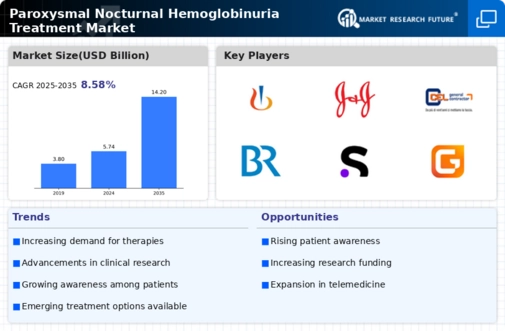The Paroxysmal Nocturnal Hemoglobinuria Treatment Market is characterized by a dynamic competitive landscape underpinned by the presence of numerous established and emerging players. The rapidly evolving nature of this industry is indicative of increasing research investments and advancements in treatment protocols that target paroxysmal nocturnal hemoglobinuria.
Key factors contributing to this competitive environment include innovative product development, strategic collaborations, and mergers and acquisitions that bolster market penetration. Major players in the Paroxysmal Nocturnal Hemoglobinuria Treatment Market have focused on addressing unmet needs by enhancing therapeutic outcomes and patient care through comprehensive treatment strategies.
The competition is not solely focused on pharmaceuticals; players are also investing in breakthrough therapies, which further elevates the stakes in the treatment landscape. The Paroxysmal Nocturnal Hemoglobinuria Treatment Market is witnessing a trend toward personalized medicines, emphasizing the importance of tailored therapeutic regimens to improve patient outcomes.
With frequent regulatory updates and a growing understanding of the disease, leading Paroxysmal Nocturnal Hemoglobinuria Treatment Market players continue to refine their approaches, thereby solidifying their market positions amid intense competition.
A prominent company in the Paroxysmal Nocturnal Hemoglobinuria Treatment Market is Alexion Pharmaceuticals. Renowned for its commitment to rare disease therapies, Alexion has developed a portfolio that addresses critical healthcare needs for patients suffering from paroxysmal nocturnal hemoglobinuria through its flagship product.
This company has leveraged extensive clinical research outcomes to broaden its treatment applications, fostering a strong reputation in the market. Alexion Pharmaceuticals emphasizes collaboration with healthcare professionals and patients, aiming to continuously gather insights that drive the next generation of treatment options.
The company invests significantly in Research and Development to innovate solutions that enhance the quality of life for patients, demonstrating a strategic focus on expanding its market share through novel therapies.
The firm's ability to navigate the complexities of regulatory frameworks while also prioritizing patient needs positions it as a leader in the Paroxysmal Nocturnal Hemoglobinuria Treatment Market development.
A notable competitor in the Paroxysmal Nocturnal Hemoglobinuria Treatment Market is Novartis. This life sciences company has an established presence in the market with a commitment to advancing treatment options for rare hematological disorders.
Novartis has pursued a multi-faceted approach, encompassing research, development, and patient support initiatives, which strengthens its competitive advantage. The company's extensive global reach enables it to effectively cater to diverse patient populations while aligning with regulatory guidelines in various regions.
Novartis emphasizes partnerships with research institutions and healthcare providers to facilitate innovative studies that can yield valuable insights for product innovation. Their focus on specialized treatments and robust supply chain management underscores their efforts to provide comprehensive solutions within the Paroxysmal Nocturnal Hemoglobinuria Treatment Market.
Through a dedication to scientific excellence and patient-centric practices, Novartis aims to enhance therapeutic options available to those living with this rare disease, thereby reinforcing its position among the leading players in the industry.





















